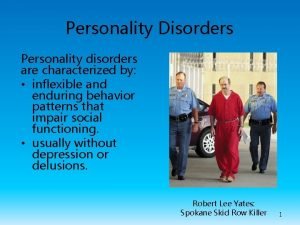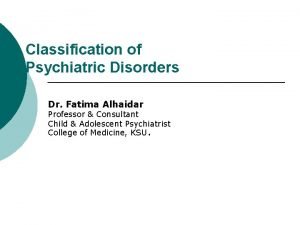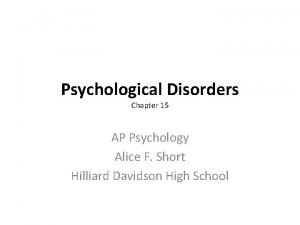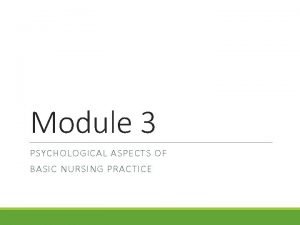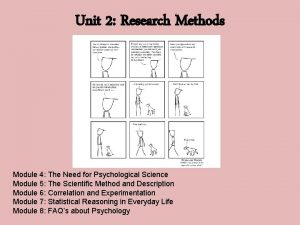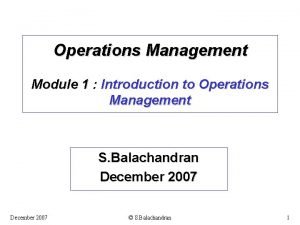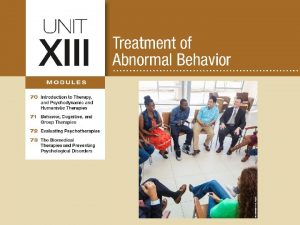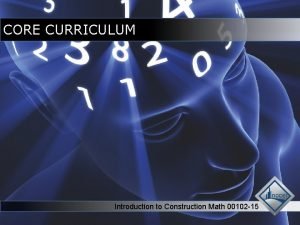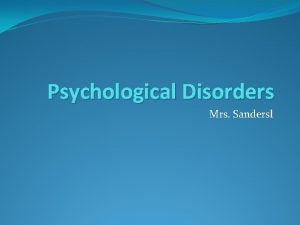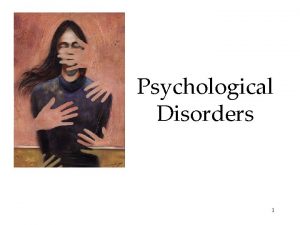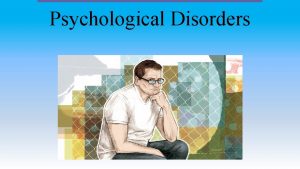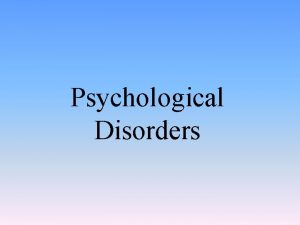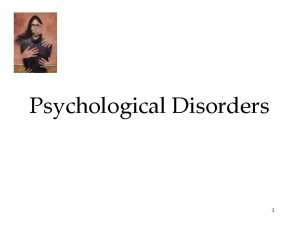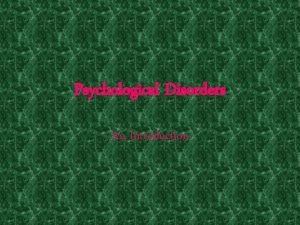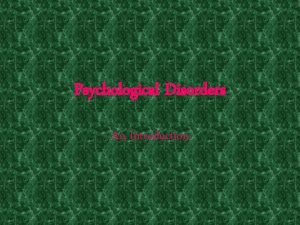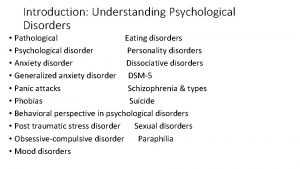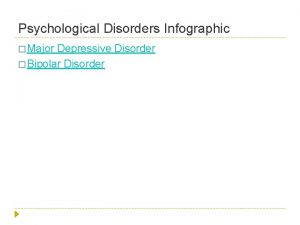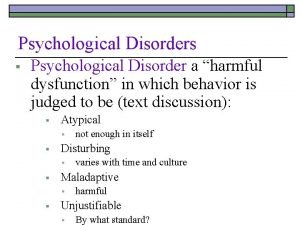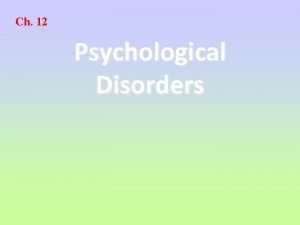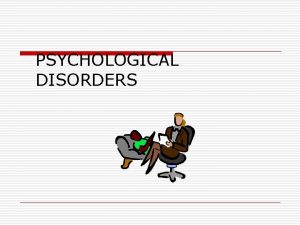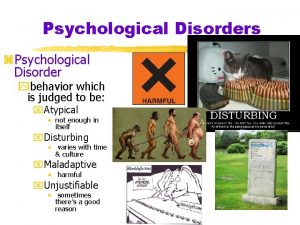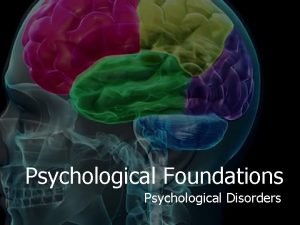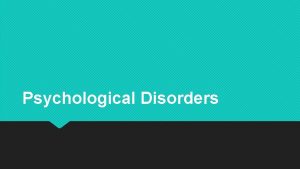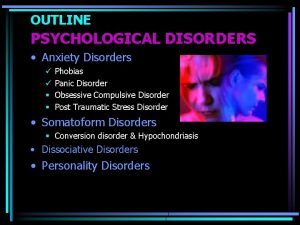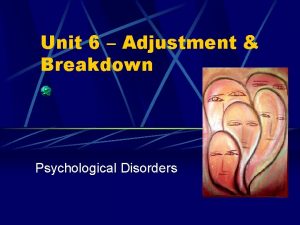Psychological Disorders An Introduction Module 65 Defining Disorder

























- Slides: 25

Psychological Disorders: An Introduction Module 65

Defining Disorder

Psychological Disorders • Psychopathology—scientific study of the origins, symptoms, and development of psychological disorders • Psychological disorder - a pattern of behavioral and psychological symptoms that causes significant personal distress, impairs the ability to function cognitively, emotionally, or behaviorally & interferes with important areas of daily life

Psychological Disorder • A “harmful dysfunction” in which behaviors are maladaptive, unjustifiable, disturbing, and atypical

MUDA • A mnemonic device used to remember the four attributes of a psychological disorder – Maladaptive • An exaggeration of normal, acceptable behaviors • Destructive to oneself or others – Unjustifiable • A behavior which does not have a rational basis – Disturbing • A behavior which is troublesome to other people – Atypical • A behavior so different from other people’s behavior that it violates a cultural norm

Understanding Disorders

Early Views of Mental Illness • In ancient times, mental illness was usually explained through a supernatural model; the person was possessed or a sinner • During the Middle Ages treatment methods were inhumane and cruel

Philippe Pinel (1745 -1826) • French physician who said mental illness was a sickness of the mind and should be viewed medically as having physical causes – Diagnosed, treated & cured in a hospital setting • Worked to reform the treatment of people with mental disorders • Encouraged more humane treatment – During his tenure directing the Paris Men’s Asylum, the death rates for patients went from 60% to 10%

The Medical Model • Mental Illnesses have physical causes that can be diagnosed, treated, & in most cases, cured. • Psychological disorders can be diagnosed based on their symptoms and treated or cured through therapy.

Bio-Psycho-Social Model • Mental illness has biological, psychological, and sociocultural factors that combine and interact to produce psychological disorders

Bio-Psycho-Social Perspective

Classifying Disorders

DSM-5 • Diagnostic and Statistical Manual of Mental Disorders – Fifth Edition • A guidebook for clinicians for diagnosis • Provides a common language to label mental disorders • Recently revised by the American Psychiatric Association – See the Changes made in this new addition • Lists and describes symptoms for 250 specific psychological disorders • Has changed significantly since the first edition

Diagnostic and Statistical Manual of Mental Disorders (DSM-V) • Describes specific symptoms and diagnostic guidelines for psychological disorders – Clinical Presentation (What are the symptoms? ) – Etiology (What causes the disorder? ) – Developmental Stage (How does this look in kids? Adults? ) – Functional Impairment (What will happen short-term & long-term? )



Labeling Stigmas • Studies show a clear bias against people diagnosed with mental disorders. • Once someone is labeled, we have a difficult time viewing them differently • Everything they do is viewed through the lens of mental illness • Which of the following is less stigmatizing: • Calling someone “schizophrenic”? • Implies the individual is the condition & doesn’t recognize the person • Calling someone a “person with schizophrenia”? • Acknowledges the person and places the mental illness in a category as a less stigmatizing physical illness label


Are People with a Mental Illness as Violent as the Media Portrays Them? • People with mental disorders are often depicted on TV as helpless victims or evil villains who are unpredictable, dangerous, and violent. • One study indicated that, overall, former mental patients did not have a higher rate of violence than a matched comparison group. • People with severe mental disorders who are experiencing bizarre delusional ideas and hallucinated voices do have a slightly higher level of violent and illegal behavior than do “normal” people. • People with mental disorders are more likely to be the victim of violence

Rates of Psychological Disorders • 26% of adult Americans “suffer from a diagnosable mental disorder • Immigrant Paradox – Mexican Americans born in the U. S. have a greater risk of mental illness compared to those who recently immigrated • Major predictor of mental illness – Poverty • Most disorders strike by early adulthood with 75% having had first symptoms by the age of 24.


Prevalence of Mental Disorders Worldwide



What does this mean to have good Psychological Well-Being? • Carol D. Ryff’s 6 core dimensions of well-being: 1. Self-Acceptance – positive attitude towards one’s self 2. Positive Relations with Other People 3. Autonomy – independent, self-determining, selfcontrolled 4. Environmental Mastery – choose & create supportive environments 5. Purpose in Life – has goals and a sense of directness 6. Personal Growth – see themselves as growing & expanding
 Non defining clause examples
Non defining clause examples Relative clauses defining and non defining
Relative clauses defining and non defining Non-defining relative clauses
Non-defining relative clauses Defining relative clause meaning in telugu
Defining relative clause meaning in telugu Defining non defining farkı
Defining non defining farkı Defining and non-defining relative clause
Defining and non-defining relative clause Chapter 18 psychological disorders
Chapter 18 psychological disorders Inflexible personality
Inflexible personality Psychological disorders
Psychological disorders Chapter 18 psychological disorders
Chapter 18 psychological disorders Chapter 14 psychological disorders
Chapter 14 psychological disorders Chapter 14 psychological disorders
Chapter 14 psychological disorders Bipolar
Bipolar Ap psychology chapter 15 psychological disorders
Ap psychology chapter 15 psychological disorders John nash roommate
John nash roommate Factitious disorder
Factitious disorder Module 3 psychological factors
Module 3 psychological factors Module 4 the need for psychological science
Module 4 the need for psychological science C device module module 1
C device module module 1 Module 4 power tools
Module 4 power tools Introduction to construction drawing
Introduction to construction drawing Intro to construction drawings
Intro to construction drawings Operations management module
Operations management module Dr carlson advises his depressed patients
Dr carlson advises his depressed patients Module 00103 introduction to hand tools
Module 00103 introduction to hand tools 00102 introduction to construction math
00102 introduction to construction math







